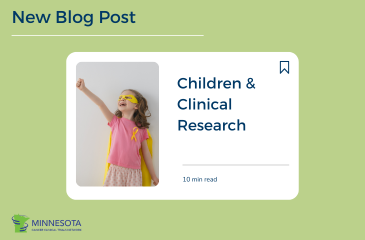Childhood Cancer Awareness Month: Children & Clinical Research
About Childhood Cancer
Childhood Cancer Awareness Month is celebrated each September around the world with the goal of increasing awareness of childhood cancer and advocating for pediatric cancer research and funding. It’s estimated that about 400,000 children and adolescents develop cancer globally each year. The most common types of cancer diagnosed in children are leukemia, brain and other central nervous system (CNS) tumors, and lymphoma. More than 100 different subtypes of childhood cancers exist.
Cancer in children isn’t necessarily the same as cancer in adults. For example, cancer in children is almost never caused by lifestyle choices, behaviors, or exposures. For children, cancer is often caused by genetics and DNA mutations, so it is more likely to be random. Sometimes childhood cancer even begins developing before a child is born. Childhood cancer also can be treated differently, and there are several specific drugs created just for pediatric cancers. While these treatments are effective, they can have long-term side effects and lead to secondary cancers later in life as children grow up and live decades beyond their initial childhood cancer.
In the United States, the five-year survival rate for pediatric cancers is 83-88%. This remarkable rate is due to childhood cancer research that developed successful diagnostic tests and treatments. However, not all pediatric populations have equitable access to cancer diagnosis and treatment, especially in lower or middle-income countries. Childhood cancer organizations work to bring awareness and funding to these populations to close treatment and diagnosis gaps.
Children & Clinical Trials
Overall, childhood cancer treatments have advanced quickly due to clinical research. Treating cancer and conducting research with children have unique considerations. It is important that cancer treatments are given to children of a variety of ages in clinical trials. This is because cancer treatments and drugs affect people differently. A child’s body may not react the same way an adult’s body would. As children grow and develop, their responses to medications also change. All age groups are needed in clinical trials to determine safety, effectiveness, side effects, and appropriate dosage for new treatments. Clinical trials for children might also determine the optimal form of a drug or device, like a liquid instead of a pill since it’s easier for children to swallow.
Children are also considered a vulnerable population. All clinical trials have regulations and safety measures in place. But, there must be even more safeguards and ethical considerations in mind when conducting research with children, especially in balancing benefits and risks of a clinical trial. This typically means that children will be the last population a treatment is given to, and the drug will already have been proven safe and effective in animals, cell models, and adults. Because children are under the age of 18, their participation must ultimately be decided by both the child and by a parent or guardian, who will be involved throughout the entire enrollment, informed consent, and clinical trial processes.
Research into Life Beyond Childhood Cancer
Another area of childhood cancer research that does not necessarily involve children is childhood cancer survivorship research. Because the survival rate for childhood cancer is so high, there are many unique concerns and questions about health outcomes for childhood cancer survivors as they reach adulthood and old age. Common concerns and issues for childhood cancer survivors include mental health issues, accelerated aging, infertility, second cancers, and reduced life expectancy. Research is needed to fully understand the consequences and effects of childhood cancer and treatments. Studies in this area typically occur by following a cohort, or group, of childhood cancer survivors over time to track their health outcomes. This type of research is considered an observational study called a cohort study.
One such study, the Childhood Cancer Survivor Study (CCSS), began in 1994 to better understand childhood cancer survivors and issues they experience, increase survival, and minimize harmful health effects of cancer treatments. The study included more than 14,000 childhood cancer survivors who were diagnosed between 1970 and 1986, as well as 4,000 siblings for comparison. A second group of 10,000 survivors that were diagnosed between 1978 and 1999 and 1,000 of their siblings were later added as well. The study participants were surveyed and followed over the years to monitor their long-term health outcomes. Potential late effects of childhood cancer that have been found from the study include premature menopause, stroke, and subsequent cancers. Data from the study has also been used in many other childhood cancer survivorship studies as well.
Learn More
To learn more about childhood cancer and identify ways to raise awareness and advocate for childhood cancer research, visit the American Childhood Cancer Organization and the Children’s Cancer Research Fund.
